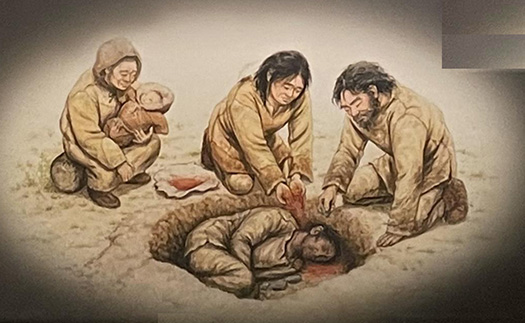
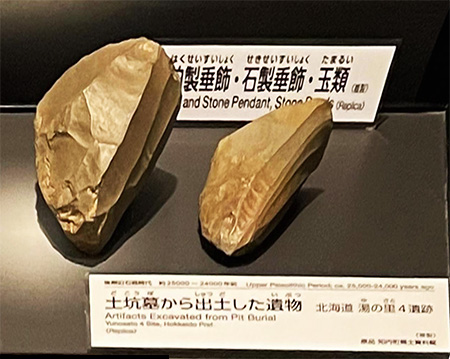

石器時代人の社会実相を再構築するような想像復元へのチャレンジ。
現代考古学に基づく研究発展の最前線を見て強く想像力が刺激される次第。
さて、人間の歴史を構成する大きな部分は逃れられない死への態度。
やがて宗教というカタチを取っていく人間の精神性・想像力の部分。
「死んだらそのあとどうなるのか?」という永遠の未知への人間の反応。
石器の時代にも集住的な社会構成が見られ、いわばその社会での経済も
見晴らすことができてきている。社会での最大の資産は人間それ自身。
成人に達するまでにさまざまな経験を積んで生き抜く知恵を持っていた個人は
社会の中でのリーダー的な存在であっただろう。
その個人に蓄積された経験知自体がかけがえのない社会行動指針。
そういう個人を死というカタチで失ったとき、社会はかれを葬送しただろうことは
もっとも基底的な人間営為として理解できる。
約20,000年前の北海道上磯郡知内町の「湯の里4遺跡」では直系1mほどの
「墓」と思われる土壙(土中に穴を掘っただけの墓)が発見されている。
この土壙には赤い顔料が撒かれていて、また玉類と石刃・石刃核が見つかった。
<石刃【せきじん】細長く両側にほぼ平行の刃をもつ剥片(はくへん)石器。
原石を適当な大きさに加工し縦長剥片を剥ぎとっていく(石刃技法)ことで、
同じ規格の石刃が大量につくられた。〜石器時代最大の「道具」だろうか。>
死者が死後も生き抜いていくのにその道具に困らないように供えられたか。
死後にも、死者の「営み」があるだろうと考えて
そのために道具を持たせるという発想は、死後の世界を「信じた」ことを意味する。
人間の色彩感覚の中で赤はもっとも根源的な象徴色。
それで彩るという考え方も、どこか納得できる部分がある。
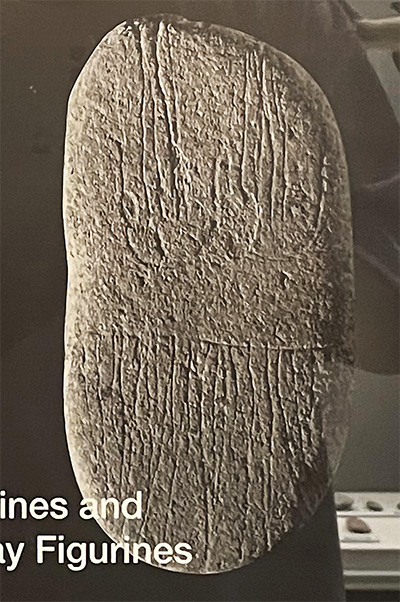
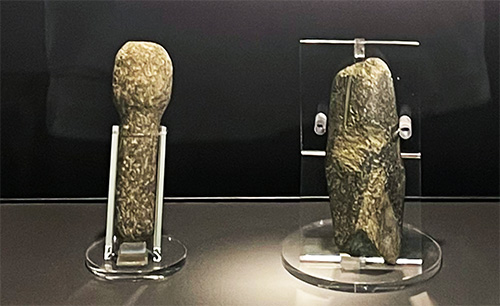
写真は14,500年前ころの愛媛県黒岩遺跡に残る線刻石版。
ヨーロッパでは旧石器時代人は洞窟壁画を描き、石版に動物画を刻み、
角製の女性像をつくった。日本列島では女性像とされる石製品や絵画的に
「線刻」された礫などがある。そこにどんな祈りが込められたか。
カタチや線刻によって、どういう人間心理が表現されたのか、
非常に強くこころに迫ってくるものを感じさせられる。
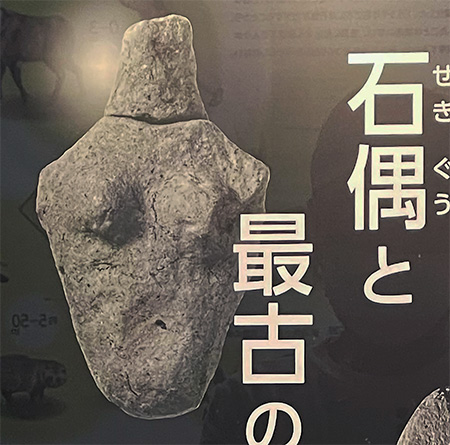
また、13,000年前ころの最古とされる「土偶」には女性的な乳房が表現された。
出産という営為への神聖感は、人類の基層的な意識に刷り込まれている。
死とともに命の再生、輪廻転生というような意識の世界が
日常を超える潜在意識として人類に普遍化していったと思われる。
若い頃「宗教とは麻薬である」という唯物史観にまみれたことがある。
しかし、こういう人類史を見つめ続けてくると
先人たちのこころの実相との大きな乖離を感じてならない。
English version⬇
Ornaments and Spiritual Traces to Death: The 37,000-Year History of the Japanese Archipelago – 6
Respect for the spirit of the ancients through the things they left behind. The inescapable conflict between life and death. The history of the spirit of belief. The history of the heart that believes in life and death.
The challenge of imaginative reconstruction that reconstructs the social reality of Stone Age man.
The frontier of research development based on modern archaeology strongly stimulates our imagination.
A major part of human history is the inescapable attitude toward death.
This is the part of human spirituality and imagination that eventually took the form of religion.
What happens after death? the human response to the eternal unknown.
Even in the age of stone tools, we can see a residential social structure and, so to speak, the economy of that society.
We are beginning to be able to see the economy of such societies. The greatest asset of a society is the human being himself.
Individuals who had gained a variety of experiences and had the wisdom to survive before reaching adulthood were
would have been a leader in society.
The accumulated experience and knowledge of an individual is itself an irreplaceable guideline for social behavior.
When such an individual was lost in the form of death, society would have buried him.
This can be understood as the most fundamental human activity.
At the “Yunosato 4 Site” in Chouchi-machi, Kamiiso County, Hokkaido, approximately 20,000 years ago, a 1-meter-long earthen mound that appears to be a “tomb” was found.
A grave pit (a grave with a hole dug in the ground), which appears to be a “tomb,” was discovered at the Yunosato 4 Site in Chinai-cho, Kamiiso County, Hokkaido, approximately 20,000 years ago.
This burial mound was covered with red pigment, and jades, stone blades, and stone blade nuclei were also found.
<Stone blades are long, slender, flaked stone tools with nearly parallel blades on both sides.
The stone blade is made by processing a rough stone to an appropriate size and removing longitudinal flakes (stone blade technique).
Stone blades of the same standard were produced in large quantities. 〜It is probably the largest tool of the Stone Age. >The dead continue to live on after death.
Was it offered to the dead so that they would not be troubled with tools for surviving after death?
The idea was that the dead would have “activities” even after death.
The idea of having tools for this purpose implies “belief” in the afterlife.
Red is the most fundamental symbolic color in the human sense of color.
The idea of coloring with it is somewhat understandable.
The photo shows a line-engraved stone tablet from the Kuroiwa site in Ehime Prefecture, Japan, dated around 14,500 years ago.
In Europe, Paleolithic people painted cave murals, carved animal paintings on stone tablets, and made horned female statues.
They also carved animal paintings on stone tablets and made horned female statues. In the Japanese archipelago, there are stone products and painted “line-engraved” gravels that are believed to be female statues.
In the Japanese archipelago, there are stone artifacts and gravels that have been “line-engraved” in the form of paintings. What kind of prayers were put into them?
What kind of human psychology was expressed by the shapes and line engravings?
The oldest known “clay figurines,” dating from around 13,000 years ago, also depicted feminine breasts.
The sacredness of the act of childbirth is imprinted in the base consciousness of humankind.
The world of consciousness, which is the rebirth of life along with death and reincarnation, has been imprinted on the human race as a subconscious that transcends the everyday.
It is thought that this world of consciousness, which transcends everyday life, has become universalized in humankind as a subconscious awareness.
When I was young, I was once mired in the materialistic historical view that “religion is a drug.
However, as I continue to look at the history of mankind in this way, I am reminded of the reality of the spirit of our ancestors.
I cannot help but feel a great discrepancy with the reality of the minds of our predecessors.
Posted on 10月 11th, 2022 by 三木 奎吾
Filed under: 日本社会・文化研究, 歴史探訪







コメントを投稿
「※誹謗中傷や、悪意のある書き込み、営利目的などのコメントを防ぐために、投稿された全てのコメントは一時的に保留されますのでご了承ください。」
You must be logged in to post a comment.